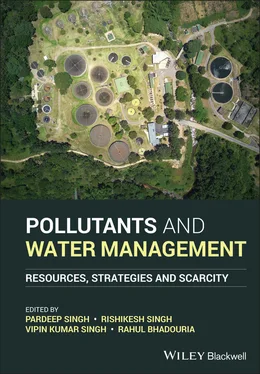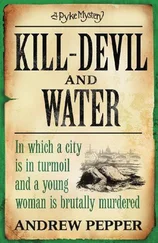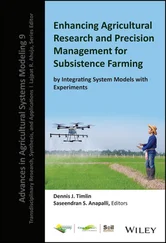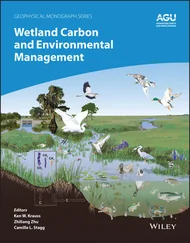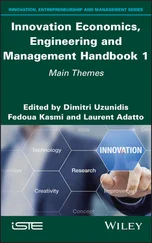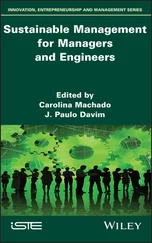Pollutants and Water Management
Здесь есть возможность читать онлайн «Pollutants and Water Management» — ознакомительный отрывок электронной книги совершенно бесплатно, а после прочтения отрывка купить полную версию. В некоторых случаях можно слушать аудио, скачать через торрент в формате fb2 и присутствует краткое содержание. Жанр: unrecognised, на английском языке. Описание произведения, (предисловие) а так же отзывы посетителей доступны на портале библиотеки ЛибКат.
- Название:Pollutants and Water Management
- Автор:
- Жанр:
- Год:неизвестен
- ISBN:нет данных
- Рейтинг книги:3 / 5. Голосов: 1
-
Избранное:Добавить в избранное
- Отзывы:
-
Ваша оценка:
- 60
- 1
- 2
- 3
- 4
- 5
Pollutants and Water Management: краткое содержание, описание и аннотация
Предлагаем к чтению аннотацию, описание, краткое содержание или предисловие (зависит от того, что написал сам автор книги «Pollutants and Water Management»). Если вы не нашли необходимую информацию о книге — напишите в комментариях, мы постараемся отыскать её.
WATER MANAGEMENT Pollutants and Water Management: Resources, Strategies and Scarcity
Pollutants and Water Management
Pollutants and Water Management: Resources, Strategies and Scarcity
Pollutants and Water Management — читать онлайн ознакомительный отрывок
Ниже представлен текст книги, разбитый по страницам. Система сохранения места последней прочитанной страницы, позволяет с удобством читать онлайн бесплатно книгу «Pollutants and Water Management», без необходимости каждый раз заново искать на чём Вы остановились. Поставьте закладку, и сможете в любой момент перейти на страницу, на которой закончили чтение.
Интервал:
Закладка:
4 Chapter 4 Table 4.1 Hazards of heavy metals on various components of ecosystems. Table 4.2 Permissible limits for common heavy metals in soil, water, and plan... Table 4.3 Overview of the current status of phytoremediation. Table 4.4 Various hyperaccumulator plants for heavy metals. Table 4.5 Utilization and development of various transgenic plants (GMOs) for...Table 4.6 Comparison of costs of various remediation techniques.
5 Chapter 5Table 5.1 Sources of common heavy metals.Table 5.2 Summary of different phytoremediation techniques.
6 Chapter 6Table 6.1 Heavy metal contaminants along with their source.Table 6.2 Overview of phytoremediation techniques.
7 Chapter 7Table 7.1 Fly ash generation and utilization in 2016–2017.Table 7.2 Fly ash generation and its utilization for 2016–2017.Table 7.3 Elemental composition of fly ash.Table 7.4 Physicochemical characterization of ash.Table 7.5 Heavy metal analysis (μg/g) and relative enrichment factor.Table 7.6 Metal accumulation in a potential plant.Table 7.7 Comparative analysis between the bioremediation of heavy metals by ...Table 7.8 Metal accumulation in roots and shoots of plants (μg/g).
8 Chapter 8Table 8.1 A list of some of the microorganisms reported for the biodegradatio...Table 8.2 Some genetically modified microorganisms for the degradation of org...Table 8.3 A list of various studies conducted to determine the effect of diff...
9 Chapter 9Table 9.1 Types of pesticides used for various purposes.Table 9.2 Categorization of dioxins in the environment.Table 9.3 Different types of phthalates in the environment.Table 9.4 Different flame retardants in the environment.Table 9.5 Different types of phenols and their functions.Table 9.6 Different types of organic pollutants and concentrations in the riv...Table 9.7 List of several organic pollutants, their limit in water bodies spe...Table 9.8 Different microorganisms used for the treatment of organic pollutan...
10 Chapter 10Table 10.1 Permissible limit of heavy metals according to the World Health Or...Table 10.2 Comparison of adsorption capacities of heavy metal ions by convent...Table 10.3 Adsorption capacities of heavy metal ions by various types of nano...
11 Chapter 11Table 11.1 Some examples of adsorption of organic and inorganic compounds on ...Table 11.2 Typical examples of spinel ferrite nanoparticles using heterogeneo...
12 Chapter 12Table 12.1 UNEP reports on HMi and their toxicological effects.Table 12.2 Different cellulose‐based material used as sorbent for HMi.Table 12.3 Two‐ and three‐parameter equations for isotherm modeling.
13 Chapter 13Table 13.1 Pressure‐driven membranes used for wastewater treatment.
14 Chapter 14Table 14.1 Arsenic concentration in various minerals/rocks.Table 14.2 Different methods and oxidants used in the oxidation of As(III) to...Table 14.3 Examples ofplant growth‐promoting microorganisms (PGPMs) use...
15 Chapter 15Table 15.1 Maximum contaminant level (MCL) standards for the most hazardous h...
16 Chapter 16Table 16.1 Traditional rainwater harvesting techniques used across different ...
List of Illustrations
1 Chapter 1 Figure 1.1 Impact of climate change on water resources. Figure 1.2 Decade‐wise average rainfall annual data of India. Figure 1.3 The flow diagram of the impact of climate change on glaciers. Figure 1.4 Impact of climate change on water quality and its association wit...
2 Chapter 2 Figure 2.1 A map showing different types of wetlands in India. Figure 2.2 Percentage of wetlands area under different categories in Bihar.... Figure 2.3 District‐wise wetland area in Bihar. Figure 2.4 A map of (a) India, (b) Bihar, and (c) study area with sampling l... Figure 2.5 Monthly rainfall (mm) variations. Figure 2.6 Monthly temperature variations. Figure 2.7 Contours lines based on water availability in different months in... Figure 2.8 Area under four land use land cover change class in 1988 and 2016... Figure 2.9 Water quality index of the Kanwar wetland. Figure 2.10 Health risk index of heavy metals via cultivated crop grains in ... Figure 2.11 Village‐wise literacy. Figure 2.12 Elevation map of the Kanwar watershed showing possible sources o...
3 Chapter 3 Figure 3.1 State distribution of grossly polluting industries in India. Figure 3.2 Status of groundwater level in India in 2018. Figure 3.3 Factors responsible for the contamination of water resources.
4 Chapter 4 Figure 4.1 Classification of various causes of heavy metal pollution. Figure 4.2 Pollution rates of various heavy metals from diverse sources incl... Figure 4.3 Schematic diagram of the categorization of remediation techniques... Figure 4.4 Flow chart for the phytoremediation of heavy metals and the utili... Figure 4.5 Schematic chart of procedures followed to develop GMOs (genetical...Figure 4.6 Schematic diagram for physiological and molecular mechanisms used...
5 Chapter 5Figure 5.1 Reverse osmosis process.Figure 5.2 Different mechanisms of phytoremediation.Figure 5.3 Phytoremediation as an interdisciplinary approach.
6 Chapter 6Figure 6.1 Different sources of heavy metals in the environment.Figure 6.2 Different types of phytoremediation processes.Figure 6.3 Bamboo ( Bambusa vulgaris ) used for the phytoremediation of heavy ...Figure 6.4 Bambusa vulgaris after two years of growth during phytoremediatio...Figure 6.5 Indian mustard plant use for the phytoremediation of heavy metals...Figure 6.6 Use of rhizobacteria with sunflower ( Helianthus annuus ) for the p...Figure 6.7 Seagrass used for the phytoremediation of heavy metals.Figure 6.8 Sunflower ( Helianthus annuus L.) plant used in the phytoremediati...Figure 6.9 Water hyacinth ( Eichhornia crassipes Mart.) plant used in the phy...Figure 6.10 Salix sp. used for the phytoremediation of heavy metals
7 Chapter 7Figure 7.1 Percentage share of various energy sources in India.Figure 7.2 Major modes of fly ash utilization during the year 2016–2017.Figure 7.3 Gandhinagar thermal power plant.Figure 7.4 X‐ray fluorescence peaks of fly ash.Figure 7.5 Phylogenetic tree for isolated organisms.
8 Chapter 8Figure 8.1 Different bioreactors used for the microbial degradation of organ...
9 Chapter 9Figure 9.1 Sources of organic pollutants.Figure 9.2 Types of organic pollutants in aquatic environments.Figure 9.3 Different organic pollutants mixed with fresh water.Figure 9.4 The effect of organic pollutants on the aquatic environment.Figure 9.5 Fate of organic pollutants in an aquatic ecosystem.Figure 9.6 (a) General mechanism of degradation of organic pollutants. (b) P...
10 Chapter 10Figure 10.1 Removal of heavy metals from wastewater by using graphene‐based ...Figure 10.2 Heavy metal removal by adsorption on gold nanoparticles by adsor...Figure 10.3 Different types of dendritic polymers.Figure 10.4 The removal of Cr 6+ions with the help of poly (amidoamine)‐graf...
11 Chapter 11Figure 11.1 Representation of the functional groups utilized in the function...Figure 11.2 Schematic diagram showing the formation of oxygen and hydroxyl r...Figure 11.3 Schematic diagram for wastewater treatment using spinel ferrite ...
12 Chapter 12Figure 12.1 The chemical structure of cellulose.Figure 12.2 The sorption mechanism in cellulose for pollutants.Figure 12.3 Different techniques for the surface modification of cellulose....Figure 12.4 Versatile applications of cellulose‐based materials.
13 Chapter 13Figure 13.1 Challenges of traditional methods.Figure 13.2 Characteristics of wastewater.Figure 13.3 Classification of membranes used for wastewater treatment.Figure 13.4 Pressure‐driven membrane processes for wastewater treatment.
14 Chapter 14Figure 14.1 Natural and anthropogenic sources of arsenic.Figure 14.2 Health effects of arsenic on humans.Figure 14.3 Different types of phytoremediation techniques for the removal o...Figure 14.4 The fate of arsenic in the environment.
Читать дальшеИнтервал:
Закладка:
Похожие книги на «Pollutants and Water Management»
Представляем Вашему вниманию похожие книги на «Pollutants and Water Management» списком для выбора. Мы отобрали схожую по названию и смыслу литературу в надежде предоставить читателям больше вариантов отыскать новые, интересные, ещё непрочитанные произведения.
Обсуждение, отзывы о книге «Pollutants and Water Management» и просто собственные мнения читателей. Оставьте ваши комментарии, напишите, что Вы думаете о произведении, его смысле или главных героях. Укажите что конкретно понравилось, а что нет, и почему Вы так считаете.
